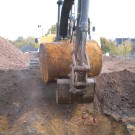Retirement apartment development – Norwich
Sector: Residential
Development detail: Construction of a three to four-storey apartment block on a sloping site formerly occupied by a petrol station/garage and in an area of known ground instability
Roles: Desk study appraisal, phased ground investigation, qualitative risk assessment, remediation implementation and verification, foundation options appraisal, ground stabilisation and piling risk assessments
-
Background:
Our experience of undertaking work across the whole of the UK suggested that this site might present some interesting geotechnical challenges.
Appropriate desk study information was obtained and this confirmed that the site was underlain by historical chalk mining. (Anyone undertaking an internet search for Norwich Bus Chalk Mine will quickly understand the potential problems that can be caused by a sudden collapse of chalk mine workings). Natural solution features also provide a geotechnical risk in chalk strata.
The property is located on a Principal aquifer and lies within a groundwater source protection zone. Given the site was previously used as a petrol station, potential pollution linkages were identified with respect to end users of the development and potable groundwater abstraction wells.
-
Our involvement:
Pre-construction remedial works involved the exhumation of underground fuel tanks and the removal of some hydrocarbon-impacted soils. No significant groundwater impaction was noted.
A piled foundation solution was recommended for the development and each pile location was probed to identify the presence of mine workings (voids or loose backfill) or natural solution features and to obtain information on likely pile length.
This work confirmed that there were areas of voided strata and loose backfill. Continuous flight auger (CFA) piles were preferred by the client. To prevent loss of concrete during piling, Crossfield Consulting designed a scheme of drilling and grouting works to infill loose and voided strata before piling works commenced. Prior to commencement of the grouting works, risk assessments were undertaken to demonstrate to the Environment Agency that the injection of grout would have no significant detrimental effect on groundwater quality.
-
The results:
Identification of the potential ground constraints prior to purchase of the site enabled our Client to budget for the extra-over costs and timescales associated with developing a site with considerable ground-related challenges.
The successful completion of this project highlighted the importance of employing a specialist with both knowledge of the development area and relevant geotechnical and environmental expertise.
Crossfield Consulting Limited
- The Granary,
White Hall Farm,
Long Itchington,
Warwickshire
CV47 9PU - +44 (1926) 815678
- +44 (1926) 815222
- mail@crossfield-consulting.co.uk




